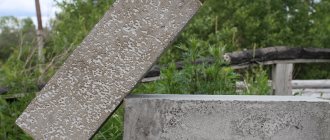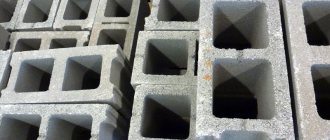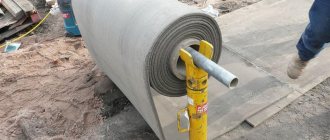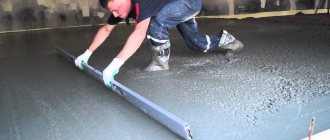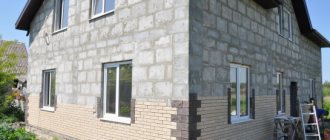In the modern world, every person wants to live in convenience and comfort. Therefore, the choice of future housing is carried out especially carefully. As a rule, people think about what type of house to choose: block, monolithic or panel.
Buyers unenlightened in construction do not see the difference between these types and are often lost in choice. This may subsequently result in dissatisfaction with the purchase. Therefore, you need to study the construction methods of each type in order to choose truly high-quality housing.
Monolithic house: pros, cons
A monolithic house is a solid cast structure. When constructing its load-bearing elements, no blocks, panels, or bricks are used, so there are no masonry joints. At the locations of the frame and ceilings, formwork is installed into which concrete is poured. If we are talking about load-bearing structures, they are additionally reinforced. The reinforcement bars are placed inside the formwork.
Advantages of building monolithic houses:
- speed of construction - even a multi-storey building with an impressive area can be built in 1-2 years, and a cottage in just 2-3 months, including the construction of the foundation;
- extensive architectural possibilities - thanks to modern formwork, elements of any complexity, size and shape can be poured;
- saving costs on foundation construction - in monolithic structures, the load is distributed evenly across all load-bearing structures, so a lightweight foundation can be used;
- relatively light weight of monolithic structures - the technology is suitable even for construction in areas with heaving or unstable soils; if necessary, piles are installed under the foundation;
- simple redevelopment - during operation, the property can be changed for certain tasks, for example, dividing premises into separate rooms or, conversely, combining them, without significantly reducing the load-bearing characteristics of structures:
- long service life - more than 150 years, walls without seams are less damaged by the environment;
- high strength and stability - monolithic houses are suitable for regions with high seismic activity and can withstand earthquakes up to magnitude 8;
- increase in usable area - by 10-15% compared to the use of other construction technologies;
- minimal shrinkage - takes no more than 1 month, after which you can immediately lay utility lines, install windows, doors, carry out repairs and put the house into operation;
- savings on paying for building materials and construction work - a monolithic house is cheaper than a block or brick one, sometimes the difference is up to 30% of the budget without loss of operational characteristics of the property;
- savings in interior and exterior finishing - the walls are initially smooth and even, so they do not require additional leveling.
It is important to know!
Monolithic houses are characterized by increased safety. For example, if a heating or water supply pipe breaks on the second floor of a house, water will not be able to immediately flow down due to the lack of seams in the ceilings. This allows you to localize the accident for a certain time and reduce the risk of damage to neighbors if we are talking about an apartment building.
Disadvantages of monolithic construction:
- The disadvantages of monolithic construction include the impossibility of performing work in bad weather conditions. For example, with excess air humidity, concrete can take a long time to dry and become damp in certain areas. If a house is built at a temperature below +5 degrees, then the solution is heated with industrial heaters or frost-resistant additives are added to it.
- It is difficult to make grooves in solid reinforced concrete for hidden installation of utility lines, so their location is provided for at the project development stage. Standard monolithic walls require additional insulation. But you can also increase the level of thermal insulation by adding expanded clay to the concrete solution
The difference between a monolithic and panel house
Both monolithic and panel houses are made of concrete. But in the first case, load-bearing structures, walls and ceilings are filled with concrete using formwork directly on the site, and in the second, the structure is assembled from ready-made elements. The minimum number of seams increases not only the strength of the structure, but also its thermal and sound insulation parameters.
Panel houses are mainly built according to standard designs. It is usually impractical to manufacture individual elements of unusual shapes or sizes in a factory. The use of formwork allows you to build houses in any architectural style. With its help, you can easily fill columns or arches, which, thanks to the reinforcement, can easily withstand any load.
Which building is warmer?
It is also important to understand which houses are better - brick, monolithic or panel - regarding their ability to retain heat.
Obviously, when choosing a building, its heat-conducting function is extremely important:
- Monolithic housing is quite warm, since, thanks to the permanent formwork, it does not freeze and has no open cracks.
- A block house lacks the advantages of monolithic multi-storey housing. Here, gaps form between the blocks, so purchasing insulation for the winter is inevitable.
- In terms of heat retention, a panel building is extremely similar to a block building. There is only one difference: in a panel house, the blocks are fastened with metal parts, so cracks in the walls will appear after a longer period of time.
To summarize, we can say that the function in question is best performed by a monolithic building, which truly combines convenience and warmth.
What is better, a monolithic house or a brick one?
Before the advent of monolithic house-building technology, brick houses were always considered the warmest and most reliable. You can build a building with any layout from brick. But it also has its limits. Therefore, for houses above 2-3 floors, the use of brickwork is irrational.
A monolithic private house is not inferior to a brick house in terms of performance characteristics. At the same time, it is more reliable and durable. The construction of monolithic walls will take 20% less time and will reduce the amount of required labor resources, which generally reduces the cost of construction.
Types of monolithic houses:
- solid monolithic;
- monolithic brick house;
- monolithic frame house.
Monolithic frame house: features and advantages
Monolithic frame houses combine the strength of the monolith and the high thermal insulation characteristics of the materials used in frame house construction.
The technology and stages of construction of such buildings are somewhat different:
- Construction of the foundation. A monolithic slab is poured or a ready-made reinforced concrete product is used.
- Construction of load-bearing structures. They are poured with concrete after installing the formwork and reinforcing elements. The result is a solid concrete frame.
- Installation of internal walls and partitions. If the elements are not part of the supporting structure, they are made of foamed concrete or multi-layer wall panels.
A monolithic frame house retains high reliability and resistance to seismic influences. But the possibility of redevelopment of premises is significantly simplified and the options for finishing finishing work are expanded. This technology expands the list of architectural features of cottages. For example, arches, bay windows and panoramic glazing are often used.
Monolithic brick house
A feature of monolithic brick houses is the ability to fill the space between load-bearing cast elements with brickwork.
Because of this, the technology for performing the work changes a little:
- The foundation and formwork of the load-bearing elements are being poured.
- Builders manually lay brick walls and partitions.
- Finishing work is carried out comprehensively after the concrete has completely hardened and the brickwork has settled.
Construction of a monolithic brick house allows you to reduce the cost of renting special equipment. In this case, the building receives all the advantages of a brick house, such as increased thermal insulation or ease of redevelopment.
Recommendations from experts
It’s worth listening to the opinions of experts before you finally make your choice.
Recommendations for home buyers:
- Before purchasing an apartment, you should try to clearly consider all the options: visit apartments in block, panel and monolithic buildings, feel the walls. Then choosing the appropriate option will be much easier.
- You should take the time to go to a hardware store. There you can study the options for blocks and jumpers between them so that you know what to deal with when buying an apartment.
- If the optimal housing has been chosen, then it’s time to get to know your neighbors. It often happens that residents move to another location from apartments that were ideal for them, only because of their neighbors. Therefore, it is worth taking this important factor into account.
Experts recommend choosing housing made of brick, since there are many more advantages than disadvantages. But if the budget does not allow you to purchase an apartment in a brick building, you should consider monolithic or monolithic-brick buildings.
Features of the technology
The foundation for a monolithic house is a reinforced concrete slab with a thickness of 1 meter. It is cast directly at the building construction site. This allows you to connect it to the walls without seams. On soft soils, piles can be pre-installed to increase the reliability of the foundation.
The strength of monolithic structures is ensured by reinforcement. This means that before the concrete is poured, a three-dimensional mesh of steel rods is installed inside the formwork. They are twisted with wire or welded together. Reinforcement further prevents cracking of concrete structures, increases their resistance to tensile loads, and improves the seismic stability of the house.
After concrete is poured into the formwork, it is further compacted to avoid the formation of air cavities. For this purpose, a deep vibrator is used. His mace is dipped into the concrete mixture. Under the influence of vibration, air bubbles rise to the surface and dissolve.
Technology of pouring concrete into formwork during the construction of a private house
- It is necessary to pour no more than half a meter of concrete at a time, after which it must be compacted. The process takes place using special deep vibrators. The latter knock out air bubbles from the mixture and also help the particles of the mixture fit more tightly together;
- You can pour not only ordinary concrete into the formwork, but also many of its lightweight types (foam concrete, aerated concrete, sawdust concrete and others). At the same time, the walls acquire better insulating qualities, but at the same time become less durable and also absorb moisture better;
- The reinforcement process most often occurs with the help of reinforcing bars, although in some cases a metal or even plastic wall acts in this capacity. At the same time, thick reinforcing bars can act as a kind of “cold bridges,” thus reducing the thermal insulation of the walls;
- The full strength gain of poured concrete walls takes about a month to a month and a half. Starting finishing work is necessary only after this period has expired.
Stages of monolith construction
At the first stage, the foundation is built. A monolithic slab and a base for future load-bearing structures are poured.
Further, the technology for constructing a monolithic house includes the following stages:
- Formwork assembly.
- Pouring and compacting concrete mortar.
- Dismantling formwork if removable panels were used.
- Protection of the concrete surface. In summer this is necessary for premature drying, and in winter to reduce freezing or exposure to precipitation.
Formwork installation technique
The formwork is assembled manually or using special equipment.
Installation steps:
- Plastic, steel or metal formwork is equipped with special fasteners or latches that secure the individual panels together. The wooden one is assembled using screws and bars. It is important that the bars are on the outside of the formwork.
- If the foundation is being poured, then roofing felt or oilcloth is laid on the bottom of the formwork, and sand or crushed stone is poured on top. This avoids the absorption of moisture and solution by the soil, which could lead to a decrease in the performance characteristics of the monolith.
- The film can also be attached to vertical surfaces. But technical oil – emulsol – is more often used. This improves the quality of the concrete surface after the monolith hardens.
- Before pouring concrete, check the evenness of the formwork in height and length. A building level is used for this.
It is important to know!
Wall formwork can be small- or large-panel. The first is used in the construction of private houses, and the second is suitable for multi-storey or industrial buildings.
Installation of formwork for pouring floors differs from wall formwork:
- Installation of metal tripods. These are racks that serve as support.
- Beams are laid out on the racks and fixed to previously poured walls or load-bearing structures. Transverse beams are superimposed on the longitudinal beams, after which a kind of lattice is formed. Formwork panels, called the bottom, are laid on it.
- The side panels of the formwork are fixed to the laid ones using latches or screws and bars. They are strictly aligned in height and checked for parallelism. Adjustments can be made using tripods.
- The surface of the formwork is lined with film. It provides the necessary tightness, which avoids leakage of the concrete solution.
- The formwork is filled with concrete to half its height. After it has set a little, reinforcement rods are inserted and the rest of the solution is poured.
Dismantling of the formwork is carried out on the 21st day after pouring the concrete solution. This period may vary depending on environmental conditions (temperature, air humidity). In 3 weeks, reinforced concrete dries to approximately 70% of its final strength.
Dismantling of the formwork is carried out gradually. So on the first day the shields are removed from the corners. In these zones, the load-bearing structures bear the least load. On the second day, the bars and locks that secure the panels from the outside are dismantled. Only after this the formwork elements themselves into which the concrete was poured are dismantled.
Preparation
In summer, the composition of the mixture will behave better during construction work than in winter.
When choosing a poured housing construction method, you should analyze the weaknesses and problems of this technique. It is difficult to build a building using this technology in winter. Low ambient temperature affects the chemical reaction of water with the components of the solution - as a result, concrete quickly hardens. And also, under the influence of frost, the liquid begins to expand, destroying the monolithic structure of concrete, which negatively affects its strength, which, in turn, negatively affects the cold resistance and water resistance of the material. The optimal time of year for the construction of a monolithic concrete building is summer, when above-zero ambient temperatures promote the occurrence of chemical reactions necessary for the preparation of high-quality material.
Next, they begin design work and choose a suitable plan for future housing. After this, the construction process begins directly on the allocated site. The foundation of the house is being constructed. To do this, dig a trench, going deep below the freezing level of the soil. After forming the sand-crushed stone cushion and laying the reinforcement frame, they begin pouring the foundation for the concrete house.
Basic work consists of forming the foundation of future housing.
To securely place the walls on the base of the building, the base must rise 0.5 m above the ground level.
Types and features of the use of formwork
Formwork differs in several characteristics:
- Material of manufacture. For the production of individual elements, aluminum, steel plates, plastic, wood, and polystyrene foam are used. The first formworks were always made of wooden planks or plywood.
- Practical purpose. Formwork can be wall (walls and vertical structures), horizontal (foundations, floors) and non-standard (columns, arches).
- Shape of elements. Formwork can be panel or tunnel. The first is assembled from separate shields. This allows you to adjust the dimensions or shapes of individual monolithic structures directly on site. The tunnel was initially adjusted in size according to the approved construction project.
- Possibility of reuse. It can be removable or non-removable. The first one, after pouring and hardening of concrete, can be dismantled for reuse. The non-removable one hardens together with the concrete mortar and subsequently becomes a structural element. Another subtype of formwork is “floating”. It is used when pouring a monolithic submersible foundation. The shields are attached to the walls of the pit. Roofing felt or cardboard is fixed to them with self-tapping screws along the perimeter.
It is important to know!
Permanent formwork is often used in the construction of cottages. Its use is not practical for the construction of multi-storey buildings. Removable formwork panels are large in size and are used on site many times, so there is no need to spend money on purchasing new ones.

